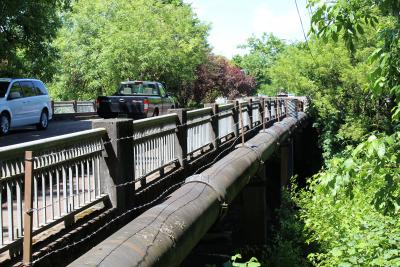Major Water Project Will Replace Pipes Spanning Marys River
The City of Corvallis Public Works Department will begin a major project this summer to replace two large water pipelines that cross the Marys River and deliver treated drinking water to the north and northwest portions of Corvallis.
Most drinking water in Corvallis is produced at the Taylor Treatment Plant on the south side of the City. Water from the Taylor plant is delivered to customers on the north side of town through cast iron pipes attached to two bridges over the Marys River – a 24-inch pipe on the 15th Street bridge near Avery Park, and a 20-inch pipe on the 4th Street bridge near Shawala Point.
These two waterline crossings were identified in a 2003 report as being particularly vulnerable in the event of an earthquake. As a result, city engineers have been working to develop a plan and identify funding to replace these two critical components of the City’s municipal water system. The plan required multiple layers of approval from local, state, and federal agencies due to the in-water work required to replace the pipes. The two-phase project is expected to break ground in August 2019, with no water service interruptions expected with either phase. Depending on scheduling, Phase 2 may begin before Phase 1.
Phase 1 - 15th Street Crossing
The plan for the 15th Street crossing is to shift the pipe alignment to the east, away from the bridge, and use horizontal directional drilling to run 1,200 feet of new pipe under Marys River, emerging near Pioneer Park and then tying into the existing water distribution system. The new pipe would run about 60 feet below the bottom of Marys River, well below any existing infrastructure. Using the horizontal drilling technique will allow the project to be completed quickly, with a minimal impact on traffic and park operation.
Phase 2 - 4th Street Crossing
The waterline crossing at 4th Street is a bit trickier, as it involves an area of Corvallis that is already heavily used by business owners and the Oregon Department of Transportation, which controls access to the land beneath the Highway 20/34 overpass and bridges. The plan for the 4th Street crossing is to shift the pipe alignment to the west and increase the size of the pipe from 20 inches to 36 inches. To span the river, contractors plan to dig a trench into the bottom of Marys River up to a depth of 10 feet to lay the new pipe. The trench will then be filled and the riverbed would be restored to its previous condition.
During the excavation of the riverbed trench, the contractors will create temporary barriers to divert the river water around the work site. This portion of the pipeline project is expected to take about 30 days to complete. After the work is completed, the riverbank and vegetation will be restored accordingly.
This phase of the project was scheduled during the seasonal low-flow period on the Marys River, when water levels are expected to be at their lowest, to reduce the impact on the river habitat.
Public Works staff met with natural resource professionals in February 2018 to discuss the impacts from this important seismic resiliency work on the riparian environment in both locations. The conversation was extremely beneficial, with participants providing insightful suggestions and ideas on how to mitigate or reduce the impacts, which were subsequently incorporated in the project design.
“This is really a once-in-a-generation capital improvement project,” said Michael Tasman, the civil engineer leading the project for the Public Works Department. “The improvements we’re making this summer will ensure a safe and resilient water system for the Corvallis community heading into the future.”
The project is estimated to cost between $3 million and $4 million to complete, with most funding coming from water utility fees paid by water customers. For more information on the project, contact Michael Tasman at 541-766-6731 or email michael.tasman@corvallisoregon.gov.
